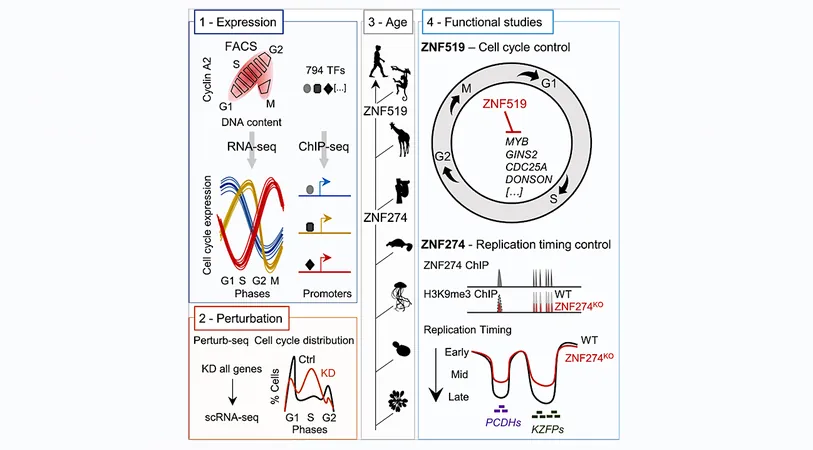
Revolutionizing Cell Division: How New Genes Are Shaping the Future of the Cell Cycle
2025-06-25
Author: Nur
Did you know that your body executes a staggering 330 billion cell divisions every single day? This incredible feat hinges on the age-old cell cycle, a process dating back to the earliest bacteria. At its core, the cycle involves doubling the cell’s contents and splitting into two ‘daughter’ cells. But in more complex creatures, like humans, this cycle has evolved into a sophisticated mechanism. So, what role do newly evolved genes play in this critical biological process?
To answer this intriguing question, a dynamic duo from Didier Trono's research group at EPFL—Romain Forey and Cyril Pulver—teamed up to explore the intersection of cell cycle biology and genomics. Along with their colleague Alex Lederer, they developed a comprehensive atlas that tracks gene activity during the human cell cycle, offering a wealth of information now accessible to both researchers and the public. Their findings were recently published in the prestigious journal Cell Genomics.
The project exemplified the interdisciplinary nature of research at EPFL. "Romain spearheaded the wet lab experiments with his expertise in cell cycles, while I tackled the genomics analyses," explains Pulver. "We blurred disciplinary boundaries, discussing and deciding on key hypotheses, mathematical modeling, and experimental procedures collaboratively. Special thanks to Alex Lederer from Gioele La Manno’s lab, whose key analysis helped position an astounding 1.9 million cells within the cell cycle based on their transcriptomes.”
Focusing on their new atlas, the researchers examined a fascinating subset of genes: those that produce transcription factors—the proteins pivotal in turning genes on or off. They made a groundbreaking discovery: some of these transcription factors, essential for guiding cells through the intricate phases of the cell cycle, have emerged remarkably recently in evolutionary terms.
The research highlights that several of these newly evolved transcription factors exert control over genes active during specific cell cycle phases. When researchers silenced some of these factors, cells either stalled at certain stages or struggled to maintain their usual timing, throwing the entire rhythm of division into chaos.
One particularly remarkable gene is ZNF519, which is exclusive to primates. When disabled, cells encountered significant challenges in accurately duplicating their DNA—a critical prerequisite for division—resulting in noticeably slower growth. The study confirmed that ZNF519 binds directly to the DNA of key cell cycle genes and functions as a repressor.
Another noteworthy protein, ZNF274, found in mammals but absent in older species like reptiles and fish, plays an impressive role by regulating when specific portions of the genome duplicate before mitosis. This function is crucial for maintaining the epigenome and organizing the cell nucleus.
"We’ve created a valuable resource that delineates human cell cycle gene expression and its perturbations, which we hope will serve our colleagues globally," says Pulver.
This groundbreaking discovery underscores how ancient processes like cell division continually integrate new genetic factors—some specifically tailored to humans and our close relatives. This has significant implications for understanding diseases such as cancer, where the cell cycle often goes awry. It may even shed light on why certain cancers or developmental disorders manifest differently in humans compared to other mammals.
In a world where science and evolution are ever-intertwined, the findings from EPFL are not just a glimpse into the past; they herald a future where the mysteries of cell division are gradually unveiled.

 Brasil (PT)
Brasil (PT)
 Canada (EN)
Canada (EN)
 Chile (ES)
Chile (ES)
 Česko (CS)
Česko (CS)
 대한민국 (KO)
대한민국 (KO)
 España (ES)
España (ES)
 France (FR)
France (FR)
 Hong Kong (EN)
Hong Kong (EN)
 Italia (IT)
Italia (IT)
 日本 (JA)
日本 (JA)
 Magyarország (HU)
Magyarország (HU)
 Norge (NO)
Norge (NO)
 Polska (PL)
Polska (PL)
 Schweiz (DE)
Schweiz (DE)
 Singapore (EN)
Singapore (EN)
 Sverige (SV)
Sverige (SV)
 Suomi (FI)
Suomi (FI)
 Türkiye (TR)
Türkiye (TR)
 الإمارات العربية المتحدة (AR)
الإمارات العربية المتحدة (AR)